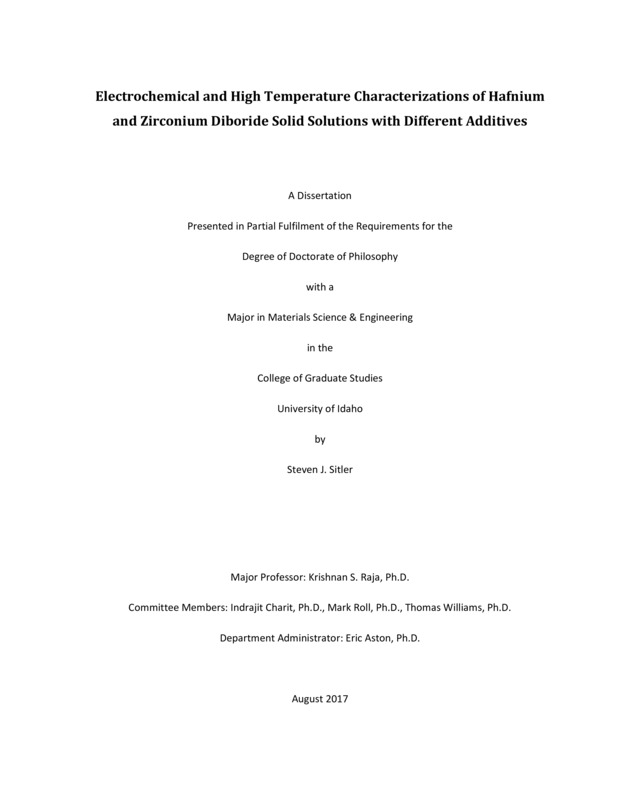Electrochemical and High Temperature Characterizations of Hafnium and Zirconium Diboride Solid Solutions with Different Additives
Sitler, Steven. (2017-08). Electrochemical and High Temperature Characterizations of Hafnium and Zirconium Diboride Solid Solutions with Different Additives. Theses and Dissertations Collection, University of Idaho Library Digital Collections. https://www.lib.uidaho.edu/digital/etd/items/sitler_idaho_0089e_11164.html
- Title:
- Electrochemical and High Temperature Characterizations of Hafnium and Zirconium Diboride Solid Solutions with Different Additives
- Author:
- Sitler, Steven
- Date:
- 2017-08
- Program:
- Chemical and Materials Science Engineering
- Subject Category:
- Alternative energy
- Abstract:
-
HfB2, ZrB2, and their solid solution mixtures were studied, primarily for electrode coating applications in coal-fired magnetohydrodynamic (MHD) direct power extraction plants. MHD works by directly extract current from superheated plasma flame (2725 °C) seeded with potassium salts. Obviously, the electrodes near this flame are subject to extreme temperatures and corrosive environments. The coating material needs to protect the electrodes from salt corrosion, oxidation, and melting, while still providing electrical conductivity. Transition metal diborides have many of the desired properties but need improvement for oxidation resistance above 1200 °C. Two main methods of oxidation resistance improvements were investigated during this research. The first was through electrochemical anodization, a process where a thin protective oxide layer is grown on the surface to prevent further detrimental oxidation at high temperatures. Several solutions, voltages, and methods were used to find an oxide layer that would protect at high temperatures. The second method was to use various additives and mixture ratios to improve densification and oxidation resistance. Ratios of HfB2 and ZrB2 tested were 1:4, 1:1, 4:1 and 1:1 with additives of Ta, Hf, and Zr metals, bringing the boron to metal ratio down to 1.86. Additionally, 1.8 mol% Gd2O3 and LaB6 were added the 1:1 ratio. Hydrogen evolution reaction kinetics were also investigated to shed some light on the ability of these materials to resist corrosion. Aqueous corrosion was also done in several solutions of different pH. The opinion of the author is that the 1:1 ratio sample with LaB6 gave the best overall results both in high temperature and aqueous experiments. More work is needed to determine if this material is viable to use as an electrode coating and it would be important to do so. Coal power currently makes up almost 40% of global electricity production. This method of extracting energy from coal can be added to any coal plant, improving its energy output. Not only would this prepare us to keep up with the ever-increasing energy demands but it could allow us to significantly cut the greenhouse gas emissions for the coal power industry.
- Description:
- doctoral, Ph.D., Chemical and Materials Science Engineering -- University of Idaho - College of Graduate Studies, 2017-08
- Major Professor:
- Raja, Krishnan
- Committee:
- Roll, Mark; Williams, Thomas; Charit, Indrajit
- Defense Date:
- 2017-08
- Identifier:
- Sitler_idaho_0089E_11164
- Type:
- Text
- Format Original:
- Format:
- application/pdf
- Rights:
- In Copyright - Educational Use Permitted. For more information, please contact University of Idaho Library Special Collections and Archives Department at libspec@uidaho.edu.
- Standardized Rights:
- http://rightsstatements.org/vocab/InC-EDU/1.0/

